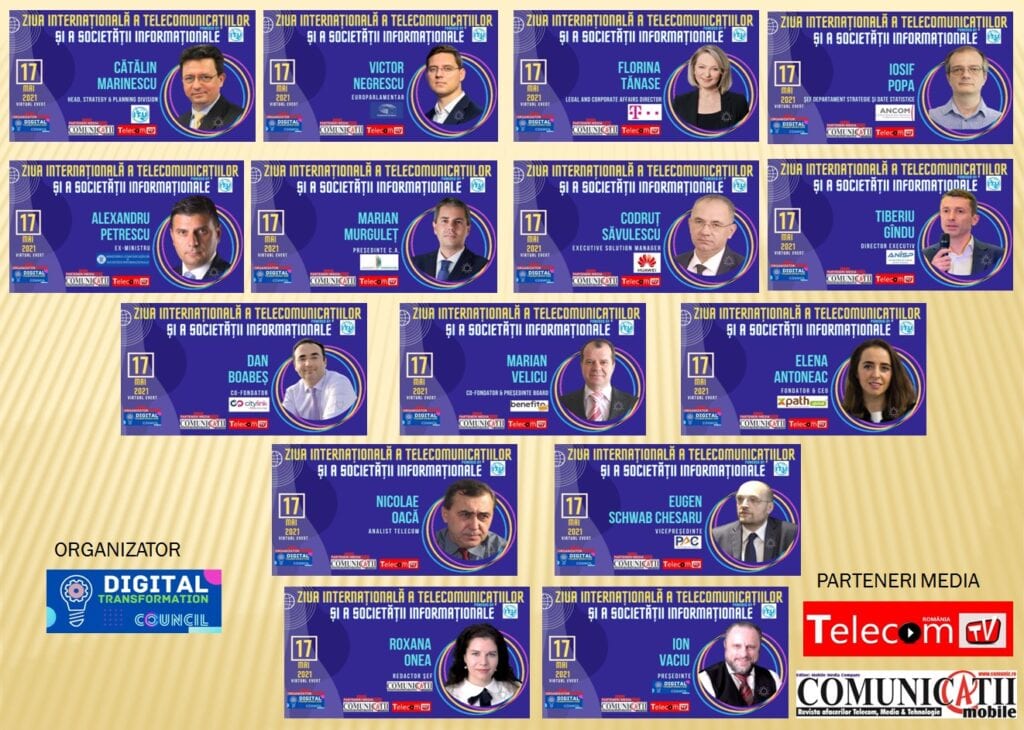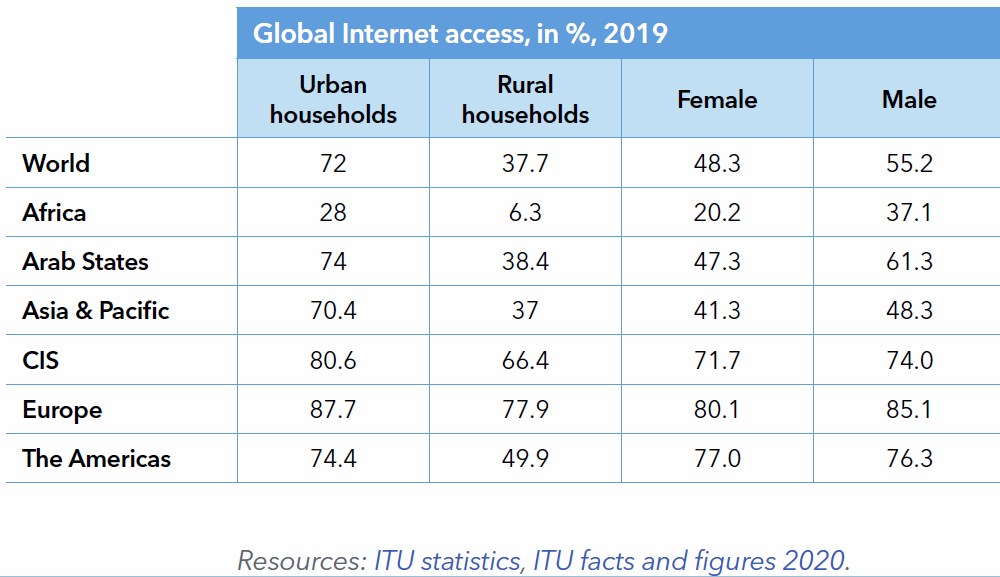ACCELERAREA TRANSFORMĂRII DIGITALE ÎN ROMÂNIA TIMPURILOR PANDEMICE
DIGITAL TRANSFORMATION COUNCIL, REVISTA COMUNICATII MOBILE şi TELECOMTV.RO au organizat pe 17 mai 2021 conferinţa virtuală dedicată ZILEI INTERNAŢIONALE A TELECOMUNICAŢIILOR ŞI A SOCIETĂŢII INFORMAŢIONALE, powered by ITU (The International Telecommunication Union).
Pandemia COVID-19 a evidențiat urgența accelerării transformării digitale, prin impulsionarea obiectivelor Agendei Connect 2030 a ITU, fără a lăsa pe nimeni în urmă.
Transformarea digitală determină îmbunătățirea experienței fiecărui cetățean și schimbarea modului în care se fac afacerile. Aceasta creşte calitatea vieții și asigură bunăstarea oamenilor, urmărind îndeplinirea Obiectivelor de Dezvoltare Durabilă ale ONU. Factorii care determină aceste schimbări variază de la tehnologii, din ce în ce mai diverse, la noi modele de afaceri, cu scopul de a oferi servicii mobile personalizate, încurajând reducerea consumului de hârtie şi a plăţilor cu numerar.
Mesajul lui Houlin Zhao, Secretarul General ITU
„Societatea informațională este una dintre principalele linii de apărare împotriva pandemiei de COVID-19. În 2021, ITU va sărbători Ziua mondială a telecomunicațiilor și a societății informaționale pentru a uni viziunile în căutarea transformării digitale din fiecare domeniu de afaceri și din toate aspectele vieții. Am dori să auzim poveștile dvs. de succes, dar și provocările dvs., cât și lecțiile pe care le-am putea învăța pentru a ne pregăti în faţa vremurilor provocatoare ce vin.”
SINTEZA DEZBATERILOR CONFERINŢEI DEDICATE
ZILEI INTERNAŢIONALE A TELECOMUNICAŢIILOR ŞI A SOCIETĂŢII INFORMAŢIONALE
| Cătălin | MARINESCU | HEAD, STRATEGY & PLANNING DIVISION | ITU |
| Victor | NEGRESCU | EUROPARLAMENTAR | PARLAMENTUL EUROPEAN |
| Iosif | POPA | ŞEF DEPARTAMENT STRATEGIE ŞI DATE STATISTICE | ANCOM |
| Florina | TĂNASE | LEGAL AND CORPORATE AFFAIRS DIRECTOR | TELEKOM ROMANIA |
| Alexandru | PETRESCU | Ex-MINISTRU | MINISTERUL COMUNICAŢIILOR ŞI SOCIETĂŢII INFORMAŢIONALE |
| Marian | MURGULEŢ | PREŞEDINTE C.A | SNR-RADIOCOM |
| Codruţ | SĂVULESCU | EXECUTIVE SOLUTION MANAGER | HUAWEI |
| Marian | VELICU | CO-FONDATOR & PREȘEDINTE BOARD | BENEFITO MOBILE |
| Dan | BOABEŞ | Co-FONDATOR | CITYLINK |
| Tiberiu | GÎNDU | DIRECTOR EXECUTIV | ANISP |
| Elena | ANTONEAC | FONDATOR & CEO | XPATH GLOBAL |
| Eugen | SCHWAB-CHESARU | VICEPREŞEDINTE | PAC |
| Nicolae | OACĂ | ANALIST TELECOM | |
| Ion | VACIU | PREŞEDINTE / MODERATOR | DIGITAL TRANSFORMATION COUNCIL |
| Roxana | ONEA | REDACTOR ŞEF | REVISTA COMUNICAŢII MOBILE |

Conferinta va fi transmisă Live pe Platforma de conferinţe COMUNICAŢII MOBILE, Youtube, LinkedIn & Facebook
RSVP:
Pentru înscriere şi detalii, vă rugăm să ne contactați la:
Digital Transformation Council
————————————–
Roxana ONEA
————————————–
Revista COMUNIC@ȚII Mobile | TelecomTV.ro
Mobil: +40.723.319.678
Email: roxana.onea@comunic.ro

Toate țările ar trebui să aibă o agendă digitală națională, o politică, o strategie, o legislație sau o declarație politică care să identifice și să enumere obiectivele lor naționale în legătură cu transformarea digitală și cum să acţioneze pentru realizarea ei. Politicile naționale pot contribui la stabilirea unei viziuni clare privind infrastructura și conectivitatea naționale. Ele pot stabili principii și priorități care ajută în definirea mecanismelor de extindere a conectivității, construind în același timp protecție și garanții online pentru membrii mai vulnerabili ai societății.
Populația trebuie să poată accesa online serviciile guvernamentale
Guvernele care vizează transformarea digitală trebuie să înceapă prin furnizarea de servicii publice centrate pe cetățeni. În timp ce inițiativele de e-guvernare variază de la țară la țară, tehnologiile digitale contribuie în mod constant la modernizarea serviciilor publice și guvernamentale și îmbunătățesc considerabil experiența cetățenilor. Angajarea în transformarea digitală urmărește îmbunătățirea modului de operare şi de furnizare a serviciilor publice, a implicării părților interesate și a modului de a oferi tuturor soluții de impact centrate pe cetățeni. De exemplu, înregistrarea online a alegătorilor, înregistrarea nașterilor și cererile de pașapoarte sunt adesea efectuate prin acces online.
Cum se pregăteşte o ţară pentru o mai bună securitate cibernetică
În această eră digitală, Încrederea este totul. Securitatea cibernetică este crucială pentru a asigura accesul universal, în siguranţă și echitabil la conectivitate. Cu toate acestea, amenințările și atacurile cibernetice dau naștere unor provocări de securitate din ce în ce mai mari, atât pentru sectorul public, cât și pentru cel privat. Acestea variază de la atacuri asupra țintelor individuale la atacuri asupra unor platforme și actori specifici sau atacuri generalizate care pot depăși frontierele naționale. Consolidarea securității cibernetice și protejarea infrastructurilor informaționale critice sunt esențiale pentru dezvoltarea socială și economică a fiecărei națiuni. Toate țările ar trebui să aibă la dispoziție un plan de acțiune, o legislație sau o declarație de politică națională de pregătire a securității cibernetice, care să identifice și să enumere obiectivele naționale în privinţa securităţii cibernetice și al atacurilor cibernetice, precum și modalitățile de protecție a infrastructurii și sistemelor naționale în caz de atac cibernetic.
Toate țările trebuie să aibă un plan național de telecomunicații de urgență, ca parte a strategiilor naționale și locale de reducere a riscului de dezastru
Toate țările ar trebui să aibă un plan național de acțiune, un cadru, o legislație sau o politică pentru pregătirea telecomunicațiilor pentru situaţii de urgență, identificând și detaliind obiectivele lor naționale în privinţa dezastrelor naturale și a situațiilor de urgență, precum și modalitățile de protejare a populațiilor, infrastructurii și sistemelor naționale. Creșterea populației la nivel global, urbanizarea rapidă și schimbările climatice vulnerabilizează tot mai multe comunități în faţa evenimentelor meteo extreme și a dezastrelor naturale ce prezintă riscuri de daune umane, inclusiv pentru infrastructura critică de telecomunicații/ ICT. Fluxul de informații în timp real este important pentru avertizarea și alertarea rapide și pentru coordonarea și articularea eficientă a activităților de răspuns pentru toate părțile interesate implicate în gestionarea dezastrelor, de la cei din linia întâi până la înalții oficiali.
Toate țările trebuie să aibă politici/ strategii care să încurajeze inovația centrată pe telecomunicații/ ICT
Toate țările ar trebui să aibă politici și strategii pentru inovarea centrată pe telecom şi ICT. Astăzi, inovația este accelerată de ICT, Big Data și AI. Inovația și învățarea pot fi formale sau informale, în timp ce „centrele de inovare” joacă un rol important în promovarea devoltării ideilor în digitalul modern.
De exemplu, Regulamentele radio stabilite la Prima Convenție Radiotelegrafică din 1906 nu numai că asigură coexistența serviciilor de radiocomunicații, dar oferă și stabilitatea necesară pentru a atrage investiții și a permite creșterea exponențială a telecomunicațiilor și a afacerilor bazate pe ICT. Ele oferă o bază solidă pentru a sprijini o varietate de sisteme radio, aplicații și tehnologii emergente care revoluționează economia digitală.
Aceste inovații au un impact pozitiv asupra vieții a miliarde de oameni din întreaga lume prin crearea unui orizont digital pentru creștere și dezvoltare durabile. Inovaţiile contribuie, de asemenea, la asigurarea conectării mai multor persoane din întreaga lume, capabile să beneficieze de o gamă extinsă de servicii digitale oferite prin intermediul comunicațiilor fără fir. Cooperarea și parteneriatele dintre toate părțile interesate ne permit să ajungem la acorduri comune adoptate de țări din întreaga lume. Între timp, standardele ITU contribuie la extinderea inovației la nivel mondial. Pe măsură ce lumea devine mai conectată, nevoia ca inovatorii să lucreze împreună este mai mare ca niciodată. Colaborarea acestora este cheia dezvoltării standardelor internaționale care să surprindă cele mai recente descoperiri în beneficiul tuturor.
Parteneriate și cooperare cu organizații și entități din ecosistemul ICT
În societatea modernă, inovația poate proveni din orice abordare. Includerea unor părți interesate noi și diverse, precum și a punctelor de vedere diferite este o modalitate de a ne asigura că schimbările sociale sunt valorificate în bine și că membrii cei mai vulnerabili ai societății pot fi protejați. Nevoia de parteneriate între diferiți actori a fost recunoscută atât în Obiectivele de Dezvoltare ale Mileniului (ODM), cât și în Obiectivele de Dezvoltare Durabilă (ODD). Formarea de parteneriate eficiente și intersectoriale între diferiți actori se dovedește esențială pentru abordarea provocărilor critice cu care se confruntă umanitatea și planeta. ITU se angajează să se asigure că parteneriatele și cooperarea sunt mai eficiente, pe măsură ce abordăm provocările cu care ne confruntăm tot mai direct.
Miliardelor de oameni le lipsesc încă beneficiile accesului la Internet
Oamenii conectați pot lucra de acasă, pot obține informații și instrumente de învățare și își pot îmbunătăți afacerile. Aceştia pot fi mai productivi la locul de muncă, se pot conecta cu cei dragi de la distanță și se pot proteja mai bine în situații de urgență. Când țările investesc pentru a conecta cetăţenii online, toată lumea câștigă. Aproximativ 4 miliarde de oameni, sau puțin peste jumătate din populația lumii, erau online până în 2019, dar celelalte 3,7 miliarde nu aveau acces la Internet și nu puteau profita de revoluția digitală. Alte sute de milioane s-au luptat cu accesul lent, costisitor și nesigur, chiar și în perioadele normale, cu atât mai grav în pandemie.

Scurt istoric
În noiembrie 2006, la Conferința plenipotențiară a Uniunii Internaționale a Telecomunicațiilor de la Antalya, Turcia, a fost proclamată Ziua internaţională a telecomunicațiilor și a societății informaționale, care se serbează anual pe 17 mai.
Această zi festivă a fost cunoscută anterior ca „Ziua Mondială a Telecomunicațiilor” (instituită la Conferința plenipotențiară ITU de la Malaga-Torremolinos în anul 1973) prin care se comemora înfiinţarea Uniunii Internaționale a Telecomunicațiilor la 17 mai 1865.
Ziua Mondială a Societății Informaționale
Ziua Mondială a Societății Informaționale a fost proclamată pe 17 mai printr-o rezoluție a Adunării Generale a Organizației Națiunilor Unite, în urma Summitului mondial din 2005 privind societatea informațională, organizat în Tunis.
Ziua Mondială a Telecomunicațiilor și a Societății Informaționale
În noiembrie 2006, la Conferința plenipotențiară a ITU din Antalya, Turcia, s-a decis sărbătorirea ambelor evenimente pe 17 mai, sub denumirea generică de Ziua Mondială a Telecomunicațiilor și a Societății Informaționale.
Obiectivul principal al acestei zilei aniversare vizează creșterea gradului de conștientizare globală asupra schimbărilor sociale pe care le determină Internetul și noile tehnologii. De asemenea, își propune să contribuie la reducerea decalajului digital.
National 5G Plans and Strategies in EU
by 5G Observatory
Austria
Main points
- Between July 2017 and September 2017, RTR launched a public consultation on 5G spectrum auctions.
- 4-3.8 GHz SCA (Simple Clock Auction) took place in March 2019.
- 700 MHz/1500 MHz/2100 MHz, expected in August 2020
- 5G Strategy for Austria, April
- All MNOs started 5G
- T-Mobile Austria 5G launch in March 2019
RTR consulted three times on 5G spectrum between July 2017 and February 2018, finally opting for a SCA on 3.4-3.6 GHz bands scheduled in February 2019. On May 28th, 2018, TKK decided on the revision of the Position Paper on Infrastructure Sharing in Mobile Networks.
The Austrian Government set up a steering group for 5G in February 2017. The “5G strategy for Austria” document was approved in April 2018.
The document defines three phases:
- Pre-commercial 5G tests are expected to be held during the first phase by mid-2018
- By year-end 2020, nationwide availability of 100 Mbps connections should be almost This creates the basis for a nationwide expansion of 5G. At the same time, the market launch of 5G in all provincial capitals should take place.
- In Phase 3, 5G should be accessible across the main traffic roads by year-end 2023, followed by nationwide coverage two years
It lists 24 actions in terms of spectrum, funding, research…, translating into ten concrete measures for 5G applications.
On Dec 20, 2018, the consultation on the product and auction design for the award 700/1500/2100 MHz started. The tender is expected in autumn 2019 and the auction in Q1 2020.
In June 2019, RTR issued a consultation on potential assignments of the 2.3 GHz and 26 GHz bands. The 2.3 GHz band was mentioned in the 2016 Spectrum Release Plan whereas the 26 GHz was not.
In August 2019, the Austrian Government announced the new national broadband strategy ‘Breitbandstrategie 2030’. The strategy aims to provide nationwide access to gigabit-capable broadband services by the end of 2030.
The goals are:
- Nationwide access to 100 Mbps speeds by end 2020
- Launch 5G in all federal state capitals by end 2020
- Becoming a ‘5G pilot country’ by early 2021
- 5G coverage along all main traffic routes by end-2023
- Nationwide coverage of 5G by the end of
In September 2019, the RTR chief said 700/1500 (eight blocks of 10 MHz) /2100 MHz (12 blocks of 2×5 MHz) frequencies to be auctioned in March 2020 will be granted under coverage conditions. A public consultation on conditions and targets was open till October 21, 2019. The government aims for main traffic routes to have 5G services available by the end of 2023, and to have “virtually nationwide” 5G coverage by the end of 2025. 700 MHz licences will include coverage of 900 underserved communities with speeds of 30 Mbps download and 3 Mbps upload, 90% of federal and state roads – to enjoy at least 10 Mbps download and 1 Mbps upload. In December 2019, the RTR published terms and conditions for the 2nd 5G spectrum auction scheduled for April 2020: it decided to lower the minimum bid by 55 million EUR to 239.3 million EUR, it also increased the duration of the licences from 20 to around 25 years. The auction was postponed due to Covid-19 in the second half of August 2020 instead of April 2020.
In April 2020, the draft regulation on security measures for 5G networks was debated. The draft ordinance proposed in Austria establishes (a) a common set of rules applicable to all telecommunications networks; and (b) particular obligations for operators to protect the security of 5G networks (for networks with more than 100,000 users). The rules established for operators include:
- the obligation to notify a security incident that has a significant impact on the security of the communications network;
- the obligation to design and implement a security policy that ensures an adequate level of security in relation to existing risks;
- a set of obligations for 5G network operators with more than 100,000 users, such as:
- to regularly submit an audit report;
- to submit a declaration of conformity attesting to the observance of international standards such as 3GPP, expressly mentioned in the annex of this order;
- to ensure the operation of the network operations center and the security operations center in the European Union;
- to effectively monitor all critical components and sensitive parts of 5G networks through the network operations center and the security operations center;
- to prevent unauthorized change of networks or components;
- to ensure the physical protection of the critical and sensitive components of 5G networks;
- restrict access to competent and qualified personnel, previously subject to security checks;
- use of appropriate tools to ensure software integrity when operating software updates;
- to establish a strategy to ensure the provision of infrastructure by several providers, including by taking into account technical constraints and interoperability requirements in different parts of other 5G
In May 2020, Vienna announced it plans to increase 5G coverage by subsidizing new sites deployment locally between July 2020 and June 2022. The city expects to spend 20 MEUR.
Belgium
Main points
- Draft strategic plan 2020-2022 late in 2019 opened to public consultation including information about the planned multi-band spectrum auction.
- BIPT granted temporary 5G 6-3.8 GHz licences to five players (Entropia Investments, Telenet, Proximus, Orange Belgium) in April 2020. Licences are valid until a traditional auction procedure takes place. Entropia Investments failed to pay for the permit and lost it in October 2020.
- Launch of 5G services by Proximus on April 1st, 2020
- 700 MHz and 3.5 GHz auction not expected before year-end 2021
Royal Decrees adopted in July 2018 among which draft regarding the 700 MHz, 1500 MHz and 3600 MHz bands. Plans released in September 2018.
In July 2018, Royal Decrees were adopted among which draft regarding the 700 MHz, 1500 MHz and 3600 MHz bands. In September 2018, the BIPT released its plans for the introduction of 5G in Belgium. 700 MHz, 3400-3800 MHz and 1500 MHz (SDL, or Supplementary Downlink) frequencies are expected to be auctioned in the autumn of 2019. The 26 GHz band auction will not take place before 2021. Upper frequencies (31.8-33.4 GHz and 40.5-43.5 GHz) should be auctioned as from 2022.
The BIPT provided consultations on the introduction of 5G in Belgium in September 2018, a communication regarding the introduction of 5G in Belgium (September 2018) and the national strategy for 700 MHz band in October 2018. The BIPT gave details on the 700 MHz auction in November 2018. Bids will start at a reserve price of 20 million EUR per 5 MHz block for 20-year licenses.
In May 2019, the BIPT issued a consultation on its draft decision to deny CityMesh’s request to add some municipalities to its 3.5 GHz band licence. It also opened a public consultation to assess interest in using the 26GHz band for 5G services. It believes it possible to assign six blocks of 200MHz without migrating the band’s existing users, while a further ten blocks would be available once the spectrum is vacated.
BIPT published its draft strategic plan 2020-2022 for public consultation until December 8, 2019. The document mentions plans to award the 700 MHz, 1500 MHz, and 3.5 GHz bands, and to renew rights for the 900 MHz, 1800 MHz, and 2.1 GHz bands, which expire in March 2021. The auction has been delayed due to a disagreement over how the amount raised by the sale should be distributed.
Due to the delay in assigning 5G spectrum, BIPT decided to award temporary licensees. In March 2020, Telenet, Orange and Proximus confirmed they applied before the 28 February 2020 deadline. In April 2020, the BIPT granted temporary 5G licences to Proximus, Cegeka, Entropia, Telenet and Orange Belgium. Licensing was followed by the launch of 5G services by Proximus as from April 1st. Orange Belgium started testing 5G. Entropia Investments failed to pay for the permit and lost it. BIPT started to redistribute spectrum to other temporary licensees while Cegeka did not ask for additional spectrum. As a result, Orange Belgium, Telenet and Proximus which got 40 MHz each in April 2020, received 50 MHz while Cegekia will keep 40 MHz.
The auction is not expected before year-end 2021.
Bulgaria
Main points
- 5G border corridor Bulgaria, Greece, Serbia.
- 700 MHz and 3600 MHz 5G auction expected in 2021
- 5G launch by A1 on November 20, 2020
The Communications Regulation Commission (CRC) of Bulgaria closed a public consultation on frequency allocations in October 2017. It proposed to sell eight blocks of 5 MHz in the 1.5 GHz band (1452-1492 MHz), three paired blocks of 5 MHz in the 2 GHz band (1920-1935 MHz/2110-2125 MHz), 14 paired 5 MHz blocks of frequency division duplex (FDD) spectrum in the 2.6 GHz band (2500-2570 MHz/2620-2690 MHz), ten blocks of 5 MHz TDD spectrum in the 2.6 GHz band (2570-2620 MHz), 34 blocks of 5 MHz in the 3.6 GHz band (3430-3600 MHz) and further 22 blocks of 5 MHz TDD in the 3.6 GHz band (3645-3700 MHz and 3745-3800 MHz).
In July 2018, Bulgaria, Greece and Serbia signed an agreement to develop an experimental 5G cross-border corridor (Thessaloniki – Sofia – Belgrade) that will test autonomous vehicles.
In December 2018, Bulgaria’s telecommunications authority (CRC) opened a public consultation procedure on a draft decision to adopt an updated regulatory policy for management of radio spectrum. It includes a proposal to redistribute spectrum in the 3400-3800 MHz band for 5G use and define the conditions for use of at least 1GHz of spectrum in 24.25-27.5 GHz band.
Another public consultation was launched on elements of a new radio spectrum policy including redistribution at 1800 MHz, allocation of 2000 MHz frequencies, use of 3400-3800 MHz spectrum, conditions for releasing 1 GHz of 24.25-27.5 GHz frequencies for 5G, allocation of 700 MHz to mobile services.
In October 2019, CRC indicated it had taken actions for the harmonisation of the 5G pioneer bands by amending the regulatory framework.
In November 2019, CRC announced it planned to assign frequencies for 5G by mid-2020. The assignment was further delayed to 2021.
Croatia
Main points
- 700 MHz, 3.6 GHz and 26 GHz 5G auction planned for H1 2021
- 5G launch by Hrvatski Telekom on October 30, 2020 thanks to Dynamic Spectrum Sharing
The Strategy for Broadband Development in Croatia for 2016-2020 was adopted in July 2016. It aims at achieving full broadband deployment by a technology neutral approach. The estimated budget for the implementation of the Strategy measures is ca. 770 MEUR.
A round table on “introduction of the 5G network in Croatia” was held in May 2018. On January 25, 2019, HAKOM issued a public call for spectrum allocation in 2.5-2.69 GHz for the period of May 2019 until October 2024. The frequencies could be used for 5G.
70 MHz of the 3400-3600 MHz band is not available in north Croatia, in two counties. After November 4, 2023 the entire 3400-3600 MHz band will be available countrywide. The entire 3600-3800 MHz band will be available countrywide after July 31, 2020 while one continuous block of 100 MHz of this band has already been available from September 1, 2019.
In March 2019, Croatia adopted a new plan with 5G as a priority. At the same time, Tele2, A1 and Hrvatski Telekom were awarded spectrum in band 7 (2500-2690 MHz).
On October 18, 2019 HAKOM issued a public consultation on future assignment of 700 MHz, 1500 MHz, 3.6 GHz and 26 GHz bands. Public consultation was open until January 20, 2020 to enable all interested stakeholders to express their views and interests. As a result of the gathered information, HAKOM published a document stating the intention to conduct a public auction for the 700 MHz, 3.6 GHz and 26 GHz frequency bands. The auction was planned for H2 2020, but these plans are currently under revision due to COVID-19 epidemic.
700 MHz band in Croatia is still used for digital terrestrial television in DVB-T/MPEG-2 system. Termination of DVB-T broadcasting in this band to enable its use for wireless broadband was planned for mid-2020, together with transition to DVB-T2/HEVC system on frequencies below 694 MHz. In March 2020 HAKOM postponed transition to DVB-T2/HEVC system and releasing of the 700 MHz band for at least 6 months due to consequences of force majeure caused by COVID-19 pandemic and earthquake in densely populated area of capital Zagreb, on March 22, 2020. Release of the 700 MHz band is also largely conditioned by cross-border coordination (interference situation in 470-694 MHz) and demanding transition procedure as DTT is a dominant TV platform with 48% household’s share.
In January 2020, the Government of the Republic of Croatia has adopted a resolution on Osijek as the Croatian 5G City and Slavonia as the first Croatian region to operate 5G networks commercially. Commercial work on 5G technology in Osijek is expected by the end of 2020. 5G is a prerequisite for utilization of the potential of digital transformation as a key factor for economic growth. For the successful introduction of technology, it is necessary to encourage active co-operation between the relevant state bodies.
In June 2020, HAKOM postponed the multi-band auction (700 MHz, 3.6 GHz and 26 GHz) until the first half 2021 blaming the Covid-19 outbreak.
Cyprus
Main points
- Updated Cyprus Broadband Plan 2016-2020 [1 ]
- 700/3600 MHz 5G spectrum auction completed on 17 December 2020. Four winners: Cyta, EPIC, Primetel and Cablenet Communications Systems
In 2016, the Cyprus Broadband Plan 2016-2020 was published and updated in December 2018, in order to be aligned with the targets of the European Gigabit Society and the 5G Action Plan.
The document covers the strategic objectives, the broadband actions and the national roadmap for 5G. In the long term the objectives are 100% coverage with 30 Mbps and 50% household penetration with 100 Mbps by 2020. The Official procedure for licencing the 5G priorities bands (700 MHz, 3.6 GHz and 26 GHz) is expected in Q4 2019.
On August 30, 2019, the Cyprus government issued a consultation on its plans to auction the 700 MHz, 3.4-3.8 GHz, and 26 GHz bands. The consultation will be opened to public comment until September 27, 2019. The auction was initially scheduled for November 2019 and rescheduled for March 2020. It is now expected by year-end 2020. Licensees will have to provide 40% 5G geographical coverage within 2 years and 85% within 5 years.
In the first months of 2020, concerns about potential adverse health effects of 5G were growing in the country and no licences had been assigned.
700 MHz
Cyprus is working hard to resolve outstanding problems relating to the 700MHz band and include it in the auction of 5G spectrum since there is a cross-border coordination problem with a third country (Turkey). Six 2×5 MHz blocks of 700 MHz spectrum will be available. A spectrum cap has been set at 2×10 MHz. Licences will be offered with coverage obligations of 70% of the population and highways by year-end 2025. Data throughputs will have to be above 100 Mbps. The reservation price for each 2×5 MHz is set at 6 million EUR. Licences will be valid 20 years. The auction took place on 17 December 2020, after several postponements.
The winners are Cyprus Telecommunications Authority (Cyta), Primetel, Epic and Cablenet. The auction raised 41.6 million EUR for spectrum in the two bands (700 MHz and 3.5 GHz).
3.4 -3.8 GHz band
There is growing interest in the market for 5G, so in January 2019 the government gave three (3) pilot (trial) national licences in 3.4 -3.8 GHz band to the three (3) existing mobile operators, with 100 MΗz bandwidth each, in order to test the equipment and the relevant applications.
Eight 50 MHz blocks are available. A spectrum cap has been set at 100 MHz. Licences will be offered with coverage obligations of 70% of the population and highways by year-end 2025. Data throughputs will have to be above 100 Mbps. The reservation price for each 50 MHz block is set at 2.5 million EUR. Licences will be valid 20 years. The auction ended on 17 December 2020, after several postponements.
The winners are Cyprus Telecommunications Authority (Cyta), Primetel, Epic and Cablenet. The auction raised 41.6 million EUR for spectrum in the two bands (700 MHz and 3.5 GHz).
26 GHz
Cyprus is planning to also authorize this band according to the expected harmonized EU Decision.
Czech Republic
Main points
- Implementation and Development of 5G Networks in the Czech Republic – Towards the Digital Economy” approved by the Czech government on January 13, 2020
- National Plan for the Development of Next Generation Networks 2016-2020.
- 3.7 GHz spectrum auctioned off.
- O2 Czech Republic launched 5G in July 2020
- Spectrum auctions in the 700 MHz and 3.5 GHz frequencies completed mid-November 2020 raising 5.6 billion CZK (212.9 million EUR)
- The Government of the Czech Republic adopted the National Plan for the Development of Next Generation Networks in October
- The Czech Telecommunication Office (CTU) auctioned off 3.7 GHz spectrum in 2017 to four bidders, including two new players:
- Telecom 5G: two 40 MHz blocks 3720-3760 MHz and 3760-3800 MHz
- O2 Czech Republic: one block 3680-3720 MHz
- PODA: 3640-3680 MHz
- Vodafone Czech Republic: one block 3600-3640 MHz
- Each 40 MHz block was sold for CZK 203 million (9.2 million USD), for a total of CZK 1.015 billion.
This spectrum seems to be dedicated to “Geographically localised BWA with fixed, mobile or nomadic terminals” and not 5G[2].
700 MHz / 3.4-3.6 GHz
- Consultation for the 3.4-3.6 GHz band took place from June 2018 until January 2019.
- At the beginning of 2019, CTU gave more details on the 5G auction that includes the 700 MHz and the 3.4-3.6 GHz bands for consultation until 25 January 2019. In June 2019, the CTU published the draft plan of the 700 MHz (2×30 MHz, 703–733/758–788 MHz) and 3.5 GHz bands auction (190 MHz, 3410-3600 MHz). The auction was rescheduled to April 2020, in October 2019 and was further postponed to year-end 2020 early The minimum price for individual auction blocks will be 6.3 billion CZK (240 million EUR). Terms and condition of the auction:
- Successful bidders will have to cover municipalities currently identified as white spaces.
- They must cover 95% of the population of all these communities within three years of the allocation.
- By January 2025 100% of the backbone network of railway and road corridors, and 95% of municipalities above 50,000 must be covered.
- Within ten years the winning operators must cover 99% of the population and 90% of the territory of each district of the Czech Republic.
- Consultation launched in March 2020 on a new framework for the 700 MHz and 3.4-3.6 GHz auction. The framework will include spectrum set aside for verticals and spectrum caps.
- In March 2020, the auction was delayed later in 2020 by CTU. The regulator modified rules for the 5G auction.
- 700 MHz: two blocks of paired 10 MHz of spectrum and two blocks of paired 5 MHz spectrum are available of which 2×10 MHz are reserved for new players. The minimum prices for 700 MHz blocks are set at 700 million CZK (26.8 million EUR), 1.12 billion CZK (42.8 million EUR), and 1.4 billion CZK (53.5 million EUR).
- In the 3.4-3.6 GHz, 10 blocks of 20 MHz of spectrum are available with spectrum caps for incumbents of 60 MHz and 100 MHz for new players. It also decided to provide national roaming conditions to new players in the 700 MHz and the 3.5GHz frequencies; In addition, 40 MHz of spectrum will be reserved for industry verticals (3400-3440 MHz).
- new players can buy up to 100 MHz. O2 Czech Republic launched 5G in July 2020
- The auction ended on November 13, 2020. In the 700 MHz band, O2 Czech Republic won the 2×10 MHz block with obligations to provide national roaming and PPDR services for public emergency and security The other 700 MHz 2×10 MHz blocks are acquired by T-Mobile Czech Republic and Vodafone Czech Republic. In the 3,400-3,600 MHz band, O2 Czech Republic and CentroNet gained blocks of 20 MHz connected with obligations to lease frequencies to support Industry 4.0. T-Mobile Czech Republic, Vodafone Czech Republic and Nordic Telecom 5G also won spectrum 20 MHz blocks.
- All in all, the auction raised 5.6 billion CZK (211.9 million EUR). T-Mobile Czech Republic paid 1.89 billion CZK (71.8 million EUR), Vodafone Czech Republic 1.568 billion CZK (59.6 million EUR) and O2 Czech Republic 1.342 billion CZK (51 million EUR). CentroNet was charged 628 million CZK (23.9 million EUR), and Nordic Telecom 168 million CZK (6.4 million EUR). Poda and Sev.en Innovations participated but did not acquire any spectrum. The auction included conditions to encourage the entry of new players but none of the bidders acquired enough spectrum to be operational.
26 GHz
- In August 2020, CTU launched a public consultation on draft spectrum utilisation plan for the 26 GHz band.























